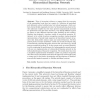Free Online Productivity Tools
i2Speak
i2Symbol
i2OCR
iTex2Img
iWeb2Print
iWeb2Shot
i2Type
iPdf2Split
iPdf2Merge
i2Bopomofo
i2Arabic
i2Style
i2Image
i2PDF
iLatex2Rtf
Sci2ools
AUSAI
2006
Springer
2006
Springer
Robust Character Recognition Using a Hierarchical Bayesian Network
There is increasing evidence to suggest that the neocortex of the mammalian brain does not consist of a collection of specialised and dedicated cortical architectures, but instead possesses a fairly uniform, hierarchically organised structure. As Mountcastle has observed [1], this uniformity implies that the same general computational processes are performed across the entire neocortex, even though different regions are known to play different functional roles. Building on this evidence, Hawkins has proposed a top-down model of neocortical operation [2], taking it to be a kind of pattern recognition machine, storing invariant representations of neural input sequences in hierarchical memory structures that both predict sensory input and control behaviour. The first partial proof of concept of Hawkins' model was recently developed using a hierarchically organised Bayesian network that was tested on a simple pattern recognition problem [3]. In the current study we extend Hawkins'...
Artificial Intelligence | AUSAI 2006 | Bayesian Network | Hierarchical Bayesian Network | Neural Network |
| Added | 20 Aug 2010 |
| Updated | 20 Aug 2010 |
| Type | Conference |
| Year | 2006 |
| Where | AUSAI |
| Authors | John Thornton, Torbjorn Gustafsson, Michael Blumenstein, Trevor Hine |
Comments (0)

